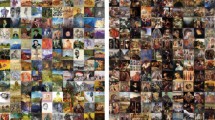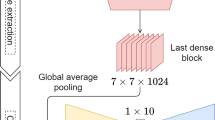Abstract
Selective classification (or rejection based classification) has been proved useful in many applications. In this paper we describe a selective clustering framework with reject option to carry out large-scale digital arts analysis. With the help of deep learning techniques, we extract content-style features from a pre-trained convolutional network for the paintings. By proposing a rejection mechanism under Bayesian framework, we focus on selecting style-oriented representative paintings of an artist, which is an interesting and challenging cultural heritage application. Two kinds of samples are rejected during the rejection based robust continuous clustering process. Representative paintings are selected during the selective clustering phase. Visual qualitative analysis on small painting set and large scale quantitative experiments on a subset of Wikiart show that the proposed rejection based selective clustering approach outperforms the standard clustering methods.













Similar content being viewed by others
References
Arora RS, Elgammal A (2012) Towards automated classification of fine-art painting style: A comparative study. In: Proceedings of the 21st international conference on pattern recognition (ICPR), pp 3541– 3544
Bartlett PL, Wegkamp MH (2008) Classification with a reject option using a hinge loss. J Mach Learn Res 9:1823–1840
Chen CC, Amato G, Boujemaa N, Inria I, Pitas I, Alexander K, Kiernan K, Li CS, Wang ZJ (2002) Report of the delos-nsf working group on digital imagery for significant cultural and historical materials
Chu WT, Wu YL (2016) Deep correlation features for image style classification. In: Proceedings of the 2016 ACM on multimedia conference, MM ’16. ACM, New York, pp 402–406
Doersch C, Singh S, Gupta A, Sivic J, Efros AA (2012) What makes paris look like paris?. ACM Trans Graph 31(4):101:1–101:9
Dumoulin V, Shlens J, Kudlur M (2017) A learned representation for artistic style. In: International conference on learning representations (ICLR). arXiv:1610.07629
Dumoulin V, Shlens J, Kudlur M (2017) A learned representation for artistic style. In: ICLR, pp 9
Fiedler M (1973) Algebraic connectivity of graphs. Czechoslov Math J 23(23):298–305
Fumera G, Roli F, Giacinto G (2000) Reject option with multiple thresholds. Pattern Recogn 33(12):2099–2101
Gatys LA, Ecker AS, Bethge M (2016) Image style transfer using convolutional neural networks. In: IEEE conference on computer vision and pattern recognition (CVPR), pp 2414–2423
Geifman Y, El-Yaniv R (2017) Selective classification for deep neural networks. In: Advances in neural information processing systems 30, pp 4878–4887. Curran Associates, Inc
Golge E, Duygulu P (2015) FAME: Face association through model evolution. In: IEEE conference on computer vision and pattern recognition workshops (CVPRW), pp 43–49
Grandvalet Y, Rakotomamonjy A, Keshet J, Canu S (2009) Support vector machines with a reject option. In: Advances in neural information processing systems 21, pp 537–544. Curran Associates, Inc
Herbei R, Wegkamp MH (2006) Classification with reject option. Can J Stat 34(4):709–721
Hicsonmez S, Samet N, Sener F, Duygulu P (2017) DRAW: Deep networks for recognizing styles of artists who illustrate children’s books. In: Proceedings of the 2017 ACM on international conference on multimedia retrieval, ICMR’17. ACM, New York, pp 338–346
Hu R, Li W, Kaick OV, Huang H, Averkiou M, Cohen-Or D, Zhang H (2017) Co-locating style-defining elements on 3d shapes. ACM Trans Graph 36(3):33:1–33:15
Hughes JM, Graham DJ, Rockmore DN (2010) Quantification of artistic style through sparse coding analysis in the drawings of pieter bruegel the elder. Proc Natl Acad Sci 107(4):1279–1283
Jain A, Gupta A, Rodriguez M, Davis LS (2013) Representing videos using mid-level discriminative patches. In: IEEE conference on computer vision and pattern recognition (CVPR), pp 2571– 2578
Jangtjik KA, Yeh MC, Hua KL (2016) Artist-based classification via deep learning with multi-scale weighted pooling. In: Proceedings of the 2016 ACM on Multimedia Conference, MM ’16. ACM, New York, pp 635–639
Karmakar B, Pal NR (2018) How to make a neural network say “don’t know”. Inf Sci 430:444–466
Karypis G, Han EH, Kumar V (1999) Chameleon: Hierarchical clustering using dynamic modeling. IEEE computer society press
Kim D, Son SW, Jeong H (2014) Large-scale quantitative analysis of painting arts. Sci Report 4:7370:1–7370:7
Li Q, Vempaty A, Varshney LR, Varshney PK (2017) Multi-object classification via crowdsourcing with a reject option. IEEE Trans Signal Process 65 (4):1068–1081
Li Y, Liu L, Shen C, Hengel AV (2017) Mining mid-level visual patterns with deep cnn activations. Int J Comput Vis 121(3):344–364
Liao J, Yao Y, Yuan L, Hua G, Kang SB (2017) Visual attribute transfer through deep image analogy. ACM Trans Graph 36(4):120:1–120:15
Liu G, Yan Y, Ricci E, Yang Y, Han Y, Winkler S, Sebe N (2015) Inferring painting style with multi-task dictionary learning. In: Proceedings of the 24th international conference on artificial intelligence, IJCAI’15, pp 2162–2168. AAAI Press
Ma D, Gao F, Bai Y, Lou Y, Wang S, Huang T, Duan L (2017) From part to whole: Who is behind the painting?. In: Proceedings of the 25rd ACM international conference on multimedia, pp 1174–1182. ACM
Macqueen J (1965) Some methods for classification and analysis of multivariate observations. In: Proceedings of berkeley symposium on mathematical statistics and probability, pp 281–297
Mao H, Cheung M, She J (2017) Deepart: Learning joint representation of visual arts. In: Proceedings of the 25rd ACM international conference on multimedia, pp 1183–1191. ACM
Pudil P, Novovicova J, Blaha S, Kittler J (1992) Multistage pattern recognition with reject option. In: 11th IAPR international conference on pattern recognition, 1992. Vol. II. conference B: Pattern recognition methodology and systems, Proceedings, pp 92–95. IEEE
Rodriguez A, Laio A (2014) Clustering by fast search and find of density peaks. Science 344(6191):1492–1496
Sartori A, Culibrk D, Yan Y, Sebe N (2015) Who’s afraid of itten: Using the art theory of color combination to analyze emotions in abstract paintings. In: Proceedings of the 23rd ACM international conference on multimedia, MM’15. ACM, New York, pp 311–320
Sartori A, Yan Y, Özbal G, Salah AAA, Salah AA, Sebe N (2015) Looking at mondrian’s victory boogie-woogie: What do i feel?. In: Proceedings of the 24th international conference on artificial intelligence, IJCAI’15, pp 2503–2509. AAAI Press
Shah SA, Koltun V (2017) Robust continuous clustering. Proc Natl Acad Sci 114(37):9814–9819
Shamir L, Macura T, Orlov N, Eckley DM, Goldberg IG (2010) Impressionism, expressionism, surrealism: Automated recognition of painters and schools of art. ACM Trans Appl Percept 7(2):8:1– 8:17
Shen J (2009) Stochastic modeling western paintings for effective classification. Pattern Recogn 42(2):293–301
Soltanolkotabi M, Elhamifar E, Candès EJ (2013) Robust subspace clustering. Ann Statist 42(2):669–699
Srivastava A, Zou J, Sutton C (2016) Clustering with a reject option: Interactive clustering as bayesian prior elicitation. In: ICML workshop on human interpretability in machinelearning(WHI). New York, NY, USA
Tax DM, Duin RP (2008) Growing a multi-class classifier with a reject option. Pattern Recogn Lett 29(10):1565–1570
Taylor RP, Micolich AP, Jonas D (1999) Fractal analysis of pollock’s drip paintings. Nature 399(6735): 422–422
van Noord N, Hendriks E, Postma E (2015) Toward discovery of the artist’s style: Learning to recognize artists by their artworks. IEEE Signal Process Mag 32(4):46–54
Wang J, Yang J, Yu K, Lv F, Huang T, Gong Y (2010) Locality-constrained linear coding for image classification. In: Computer vision and pattern recognition, pp 3360–3367
Wikiart.org - visual art encyclopedia. https://www.wikiart.org//. Accessed January 30, 2018
Zhang K, Harrell S, Ji X (2012) Computational aesthetics: on the complexity of computer-generated paintings. Leonardo 45(2):243–248
Zhang X, Hu BG (2012) Learning in the class imbalance problem when costs are unknown for errors and rejects. In: 2012 IEEE 12th international conference on data mining workshops (ICDMW), pp 194–201. IEEE
Acknowledgements
This work was supported by National Natural Science Foundation of China under nos. 61832016, 61672520 and 61702488, as well as the independent research project of National Laboratory of Pattern Recognition.
Author information
Authors and Affiliations
Corresponding author
Additional information
Publisher’s note
Springer Nature remains neutral with regard to jurisdictional claims in published maps and institutional affiliations.
Rights and permissions
About this article
Cite this article
Deng, Y., Tang, F., Dong, W. et al. Selective clustering for representative paintings selection. Multimed Tools Appl 78, 19305–19323 (2019). https://doi.org/10.1007/s11042-019-7271-7
Received:
Revised:
Accepted:
Published:
Issue Date:
DOI: https://doi.org/10.1007/s11042-019-7271-7




